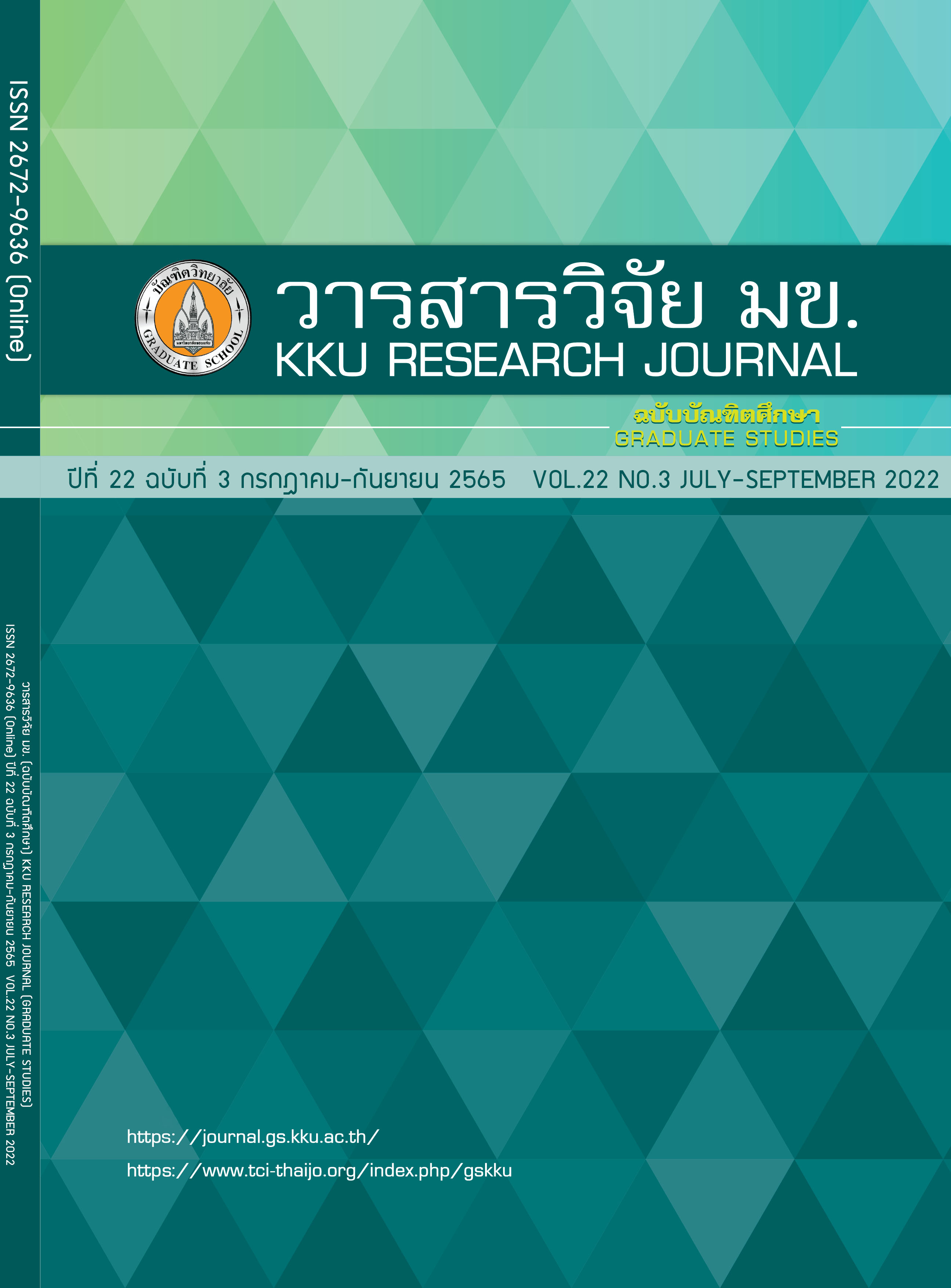Energy Efficiency Index and CO2 Emission of Public Buses in Khon Kaen City
Keywords:
Energy efficiency index, CO2 emission, Public busAbstract
Currently, transportation sector in Thailand consumes highest amount of energy and emits highest amount of CO2 emission. A replacement of existing gasoline with electric power in the city bus system is interesting. The objectives of this study are to 1) determine the factors, including service operation and vehicle characteristics, that influence energy consumption, Energy Efficiency Index (EEI), and carbon dioxide (CO2) emissions of public buses, 2) develop models for estimating energy consumption, Energy Efficiency Index (EEI), and carbon dioxide (CO2) emissions of public buses, and 3) propose a replacement of existing diesel buses with electric buses through a case study of the Khon Kaen City bus system. This study conducted interviews with bus drivers on twelve routes in order to gather information about service quality, vehicle characteristics, and fuel consumption. A multiple linear regression analysis was applied to develop the models. The results found that existing bus system has average energy consumption of 3.187 MJ/km, total energy consumption of 28,489,767 MJ/year, EEI of 0.376 MJ/P-km, average CO2 emission of 0.235 t-CO2/km, and total CO2 emission of 2,112 t-CO2/year. The factors influencing energy consumption and CO2 emission of Khon Kaen City bus system are vehicle age and average overall speed. The factors influencing EEI are average ridership and vehicle age. Replacement of existing gasoline buses with electric buses could decrease 69% of total energy consumption, 70% of EEI, and 53% of total CO2 emission.
References
Department of Alternative Energy Development and Efficiency. Energy Balance of Thailand. 2018(5).
Department of Land Transport, Transportation Statistics Group. Transportation statistics report for the year 2018.
Klungboonkrong P. Sustainable Urban Transportation Planning: Principle and Practice. Sustainable Infrastructure Research and Development Center Faculty of Engineering Khon Kaen University. 2018.
Ratanavaraha V., Jomnonkwao S. Trends in Thailand CO2 emissions in the transportation sector and Policy Mitigation. Transp Policy. 2015;41:136–146.
Thailand National Metal and Materials Technology Center. Project report on data study and potential of energy conservation in the group of trucks and buses. 2020.
Vanichbuncha K., Vanichbuncha. Using SPSSS forWindow to analyze data. 2015. Samlada printing house; 2015. 531 p.
Satiennam T, Satiennam W, Gadsadayurat S, Aranyasen S, Srisa-ard K. Vehicle kilometers of travel and fuel consumption rate for estimating CO2 emission of vehicles in Khon Kaen city. 2014:333–346.
Satiennam T, Mogi S, Hanaoka S, Nakamichi K. Estimation of CO2 Emissions for Low Carbon Urban Freight Transport in Khon Kaen, Thailand. 2015;20.
Yu Q, Li T, Li H. Improving urban bus emission and fuel consumption modeling by incorporating passenger load factor for real world driving. Appl Energy. 2016;161:101–111.
Yu H, Li M, Li J, Liu Y, Lv H, Ma K. Real-road NOx Emission and Fuel Consumption Characteristics of China IV Public Transit Buses. Energy Procedia. 2019;158:4623–4628.
Tong HY. Development of a driving cycle for a supercapacitor electric bus route in Hong Kong. Sustain Cities Soc. 2019;48:101588.
Al-Samari A. Study of emissions and fuel economy for parallel hybrid versus conventional vehicles on real world and standard driving cycles. Alex Eng J. 2017;56(4):721–726.
Lajunen A. Lifecycle costs and charging requirements of electric buses with different charging methods. J Clean Prod. 2018;172:56–67.
Lee D-Y, Elgowainy A, Vijayagopal R. Well-to-wheel environmental implications of fuel economy targets for hydrogen fuel cell electric buses in the United States. Energy Policy. 2019;128:565–83.
Ministry of Interio. Department of Provincial Administration [Internet]. 2020. Available at: http://www.kkpao.go.th/E-PlanData/?mod=index&file=datacat2-2
Department of Land Transport, Transportation Statistics Group. Transportation statistics report for the year 2021.
International Energy Agency. Energy Efficiency Indicators: Fundamentals on Statistics [Internet]. OECD; 2014. Available at: https://www.oecd-ilibrary.org/energy/energy-efficiency-indicators_9789264215672-en
Department of Alternative Energy Development and Efficiency. Energy Balance of Thailand. 2015.
Ministry of Interio. Power Development Plan 2018-2037. 2020.
Office of Transport and Traffic Policy and Planning. Executive Summary Report. 2019.
SKYWELL Thailand. SHODAI – High Roof [Internet]. 2021. SHODAI – High Roof. Available at: http://skywell.co.th/wp/line-up/shodai-high-roof/
Downloads
Published
Issue
Section
License
Copyright (c) 2022 KKU Research Journal (Graduate Studies)

This work is licensed under a Creative Commons Attribution-NonCommercial-NoDerivatives 4.0 International License.



